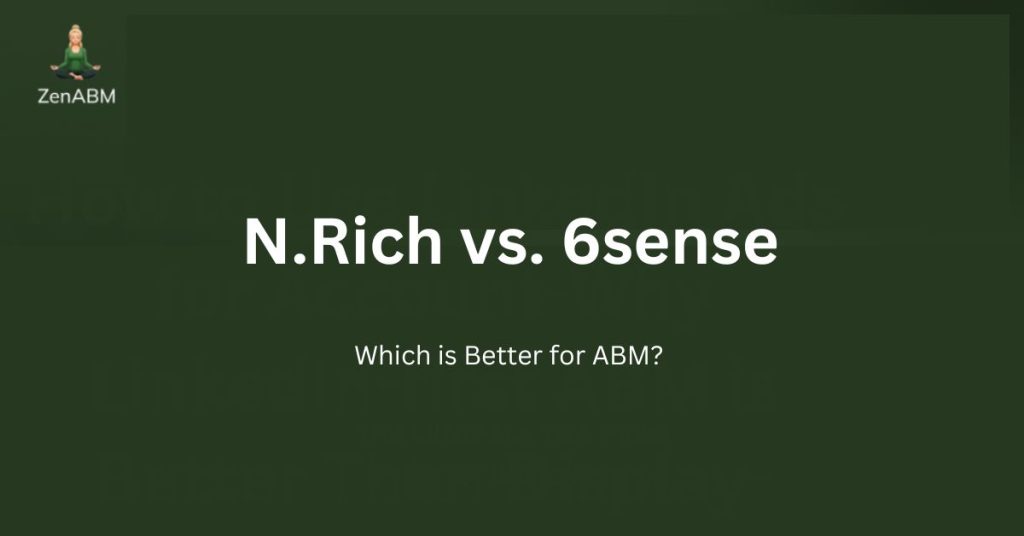In this guide, I break down how N.Rich vs. 6sense differ on features, pricing, and where they fit in an ABM stack, so marketing and sales can see which one suits their ABM motion.
I also show how ZenABM can act as a lean, LinkedIn-first alternative or serve as a complementary layer due to its unique features.

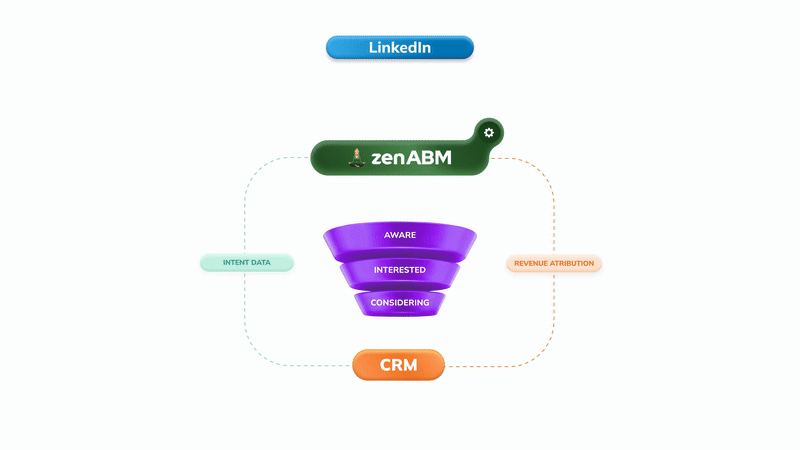
N.Rich vs. 6sense: Quick Summary
In case you’re short on time, here is the snapshot:
- N.Rich is an ABM execution layer with its own B2B DSP, dynamic ICP, third-party intent, and programmatic campaigns.
- 6sense is an AI-driven revenue and ABM platform that focuses heavily on predictive intent, buying stages, and revenue intelligence across channels.
- N.Rich runs programmatic display, supports native and video formats, and aligns with LinkedIn Ads for multichannel ABM.
- 6sense activates across display, video, CTV, LinkedIn, Facebook, Google Ads and more, plus email and sales outreach via orchestration.
- N.Rich blends first-party web and ad data with third-party intent feeds, then scores accounts and computes an ICP Sales Velocity Score.
- 6sense uses large-scale intent data and AI to assign 0 to 100 predictive scores and map accounts to buying stages such as awareness, consideration, and decision.
- N.Rich provides account-level analytics, opportunity attribution, and velocity dashboards for ABM campaigns.
- 6sense offers broader revenue analytics, multi-touch attribution, forecast views, and detailed stage movement across the funnel.
- N.Rich integrates with Salesforce, HubSpot, LinkedIn and MAPs, plus enrichment for firmographics and technographics.
- 6sense integrates with major CRMs, MAPs, sales engagement tools, web personalization, and chat tools and aims to be the central intelligence layer.
- N.Rich starts around ten thousand dollars per year, with Growth near 23.8 thousand dollars and Enterprise on custom quotes.
- 6sense typically sits in mid-five-figure to six-figure territory per year, with a Vendr median around 54,250 dollars and some quotes near 120 thousand dollars for the first year.
- Pick N.Rich if you want a programmatic ABM engine with intent, ICP and DSP execution at a premium but not extreme budget.
- Pick 6sense if you want a full enterprise revenue platform with predictive intent, buying stages, orchestration across many channels, and you have the budget and team to use it.
- A third option: ZenABM gives account-level LinkedIn ad engagement, engagement to pipeline dashboards, account scoring, ABM stages, CRM sync, first-party qualitative intent, automated BDR assignment, custom webhooks, an AI chatbot, and job title level engagement tracking, starting at $59 per month.
N.Rich Overview: Key Features, Pricing, and Reviews
N.Rich presents itself as an agile ABM execution layer for mid-market and enterprise teams, built on top of a B2B DSP with intent, ICP, and ABM workflows.
Key Features of N.Rich
Core N.Rich capabilities for ABM include ICP building, intent scoring, programmatic campaigns, and account-level analytics.
Dynamic ICP & Target Account Lists
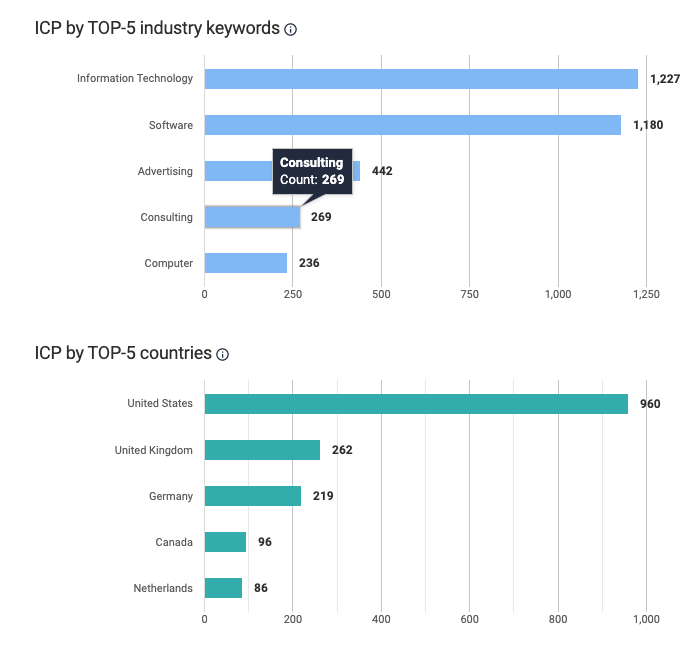
N.Rich pulls in CRM opportunity data to learn what your best customers look like, then scores new accounts against that pattern.
Target lists can be built quickly using filters such as industry, employee count, and tech stack.
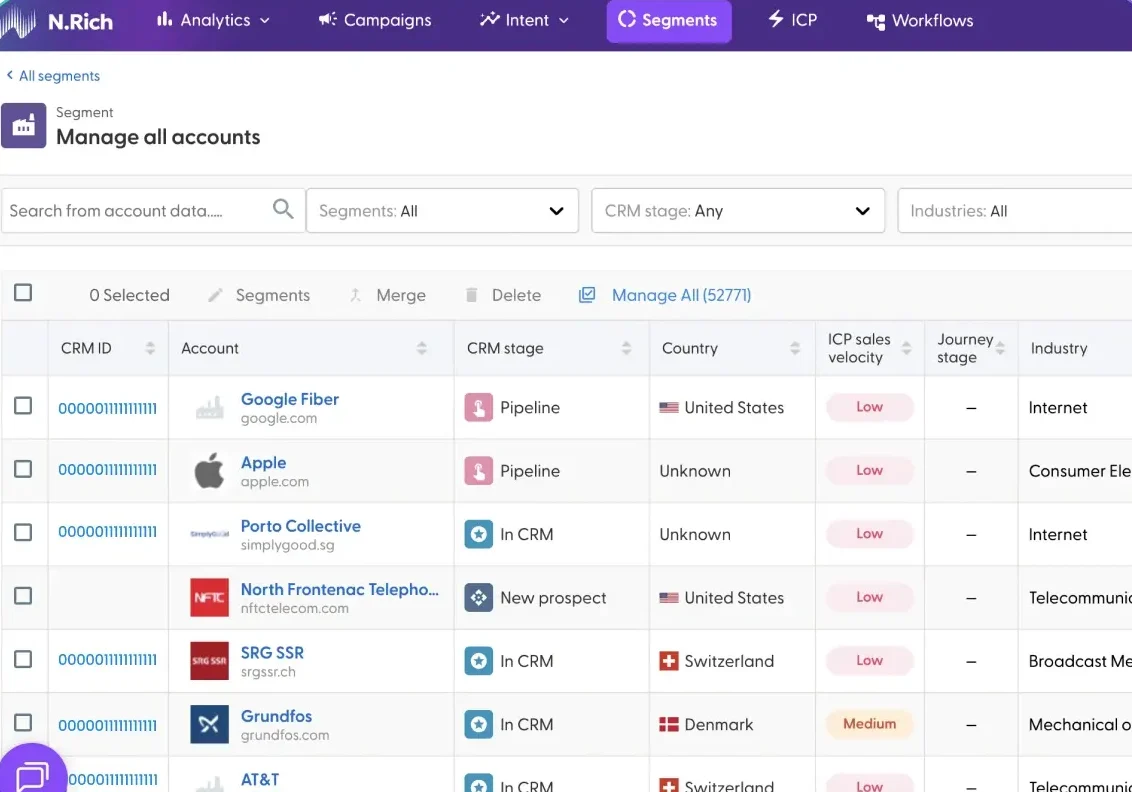
The idea is to move beyond gut-feel account picks, although results still depend on CRM data quality.
Intent Data & Account Scoring
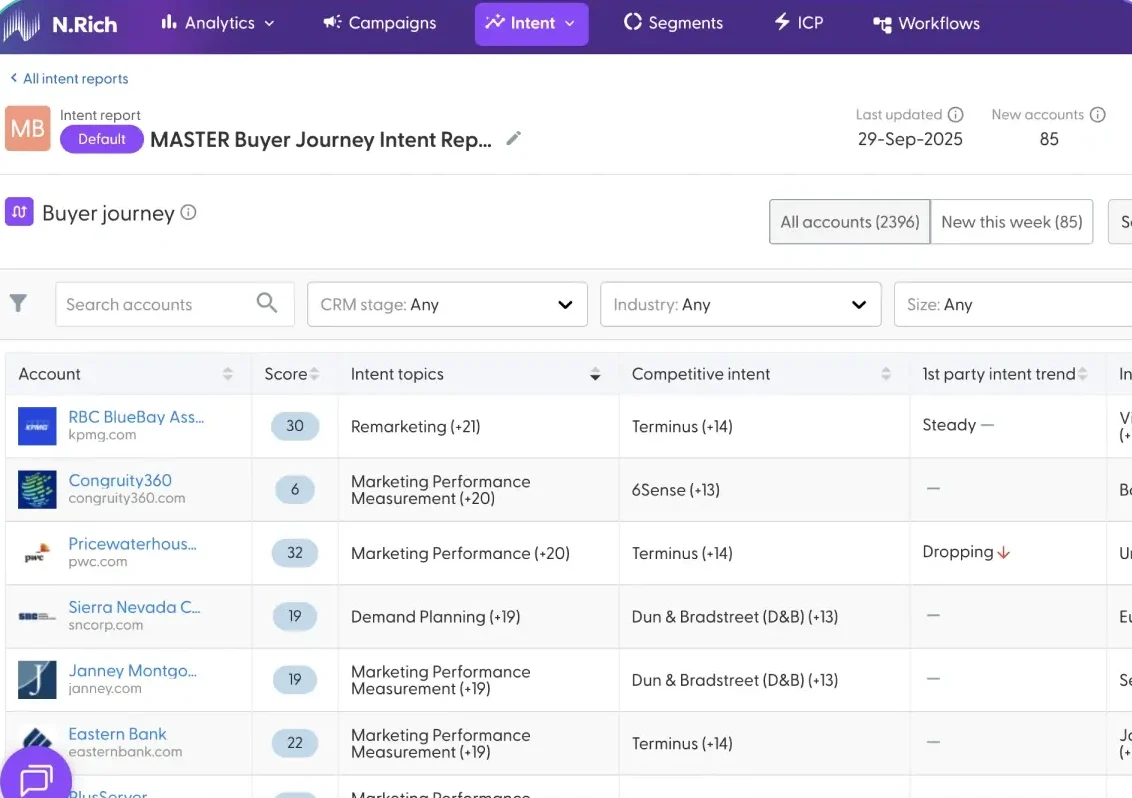
N.Rich blends first-party signals (site visits, ad engagement) with third-party intent feeds to highlight accounts researching key topics.
Accounts receive intent scores so sales and marketing can focus on those showing the strongest, consent-based interest, while topic data syncs into your CRM.
Account-Based Advertising
N.Rich ships with a built-in DSP to run programmatic display to target accounts, supporting native and video formats.
You can connect LinkedIn Ads to keep display and LinkedIn campaigns aligned, and reviewers note a simple campaign builder with bulk creatives and A/B tests.
Analytics & Opportunity Attribution
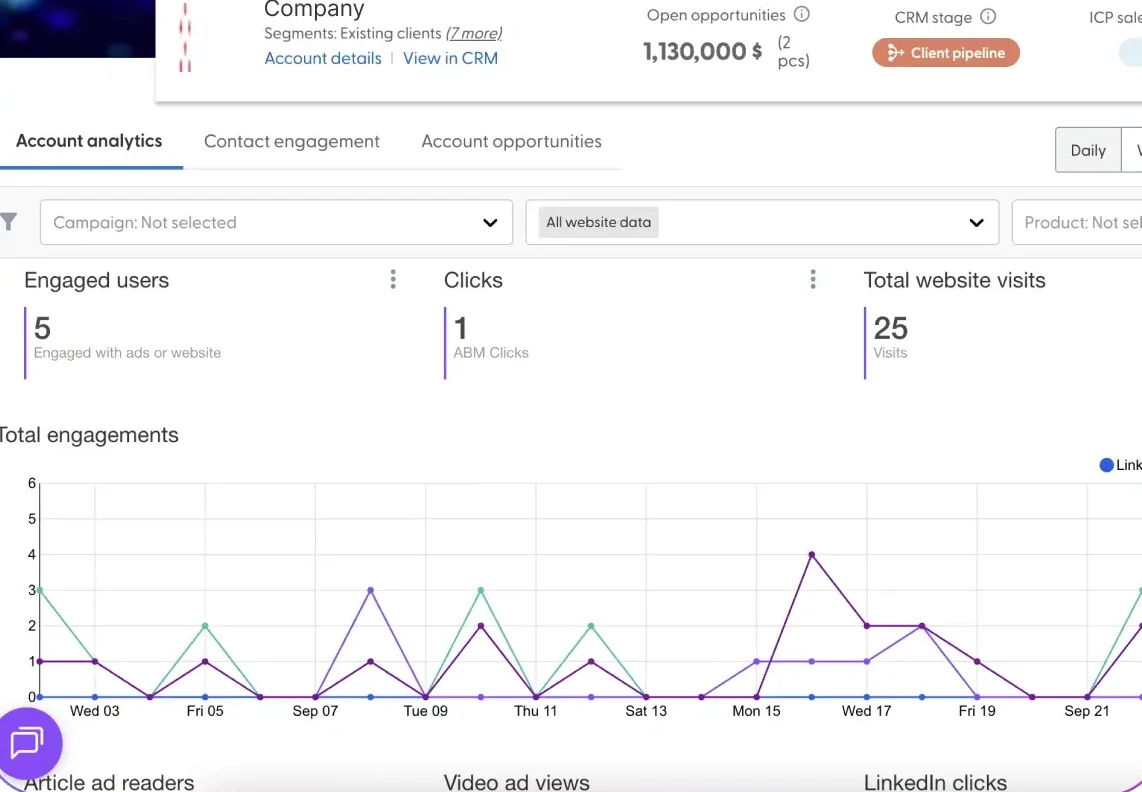
N.Rich provides account-level analytics so you can see how engagement connects to pipeline and revenue. Its Opportunity Attribution dashboard links impressions, clicks, and visits with opportunities and closed deals.
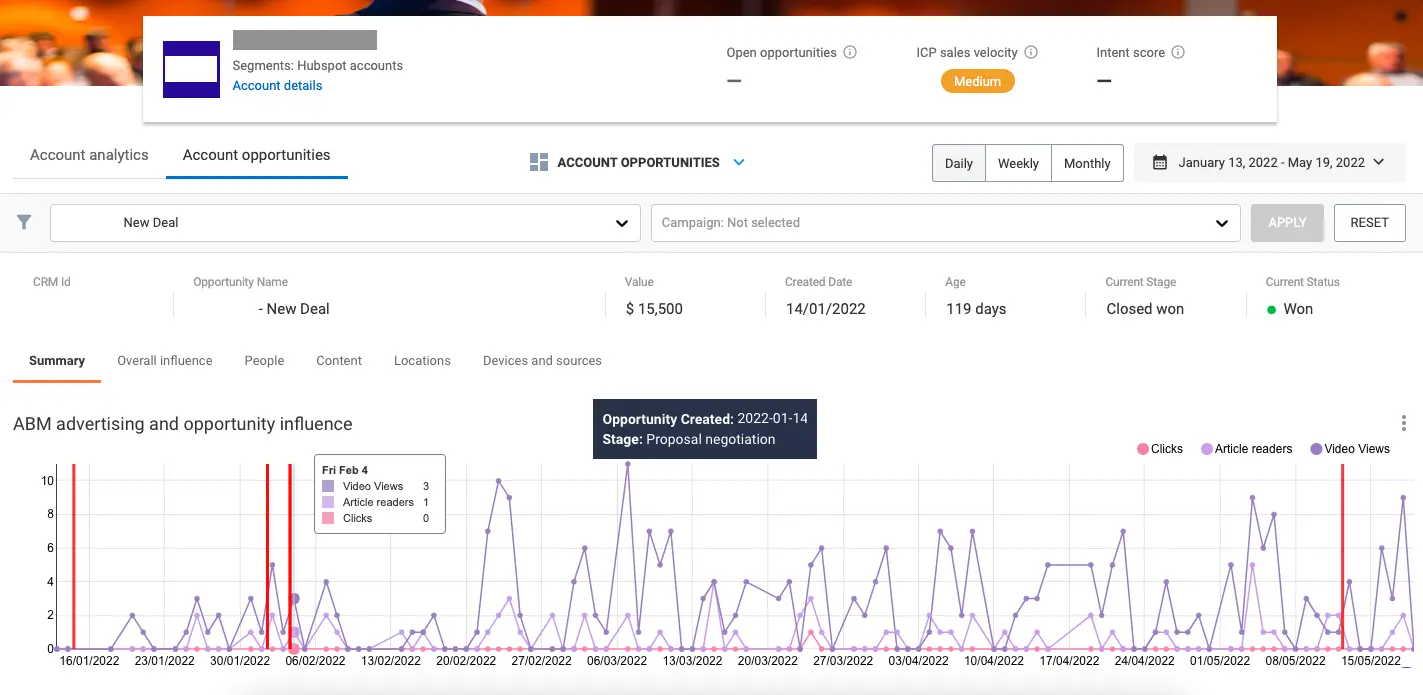

The system also calculates an ICP Sales Velocity Score for each account, with data sync back to the CRM on higher tiers.
Integrations & Data Enrichment
N.Rich integrates with the main CRMs and marketing tools. Native connectors exist for Salesforce, HubSpot (Marketing and Sales Hub), and LinkedIn (Marketing Solutions and Sales Navigator), letting you pull CRM data for segmentation and push back engagement, topics, and scores. Higher tiers add firmographic and technographic enrichment.
N.Rich Pricing: How Much Does It Cost?

N.Rich has tiered pricing tied to team size and ABM maturity. All plans aim to turn intent data into deals.
LITE: Starting at $10,320/year + $1,050 One-Time Onboarding Fee
For smaller teams starting with intent-driven ABM.
Includes 1 intent report, 10 topics, 1 marketing seat, 3 sales seats, 1 N.Rich account, 1 ABM campaign, chat support, plus:
- Intent scoring
- Unlimited firmographic and technographic data
- Website visitor identification
- Basic account analytics and alerts
GROWTH: Starting at $23,800/year
For teams scaling ABM and needing closer sales and marketing alignment.
Includes everything in LITE plus:
- More intent reports and topics
- More marketing seats and unlimited sales seats
- CRM and MAP integrations
- Opportunity attribution and more ABM campaigns
- Dedicated Customer Success Manager
ENTERPRISE: Custom Pricing
For global, mature ABM programs with advanced orchestration needs.
Includes everything in GROWTH plus:
- Unlimited intent reports and higher topic limits
- Unlimited users and multiple N.Rich accounts
- Dynamic ICP Builder and open API
- Automated workflows and strategic consulting
All plans benefit from N.Rich’s data depth and native ABM orchestration, but you still need to talk to sales for exact quotes.
Note: because N.Rich starts above $10K per year, ZenABM often looks leaner for LinkedIn first teams, starting at ~$59/month, with the top tier still under $6K per year. You still get core LinkedIn ABM essentials: account-level ad engagement tracking, account scoring, ABM stage tracking, hot account routing, bi-directional CRM sync, custom webhooks, qualitative intent, and plug-and-play ROI dashboards.

User Impressions and Reviews
N.Rich scores 4.7 out of 5 on G2 (around 99 reviews), which suggests customers are broadly satisfied.
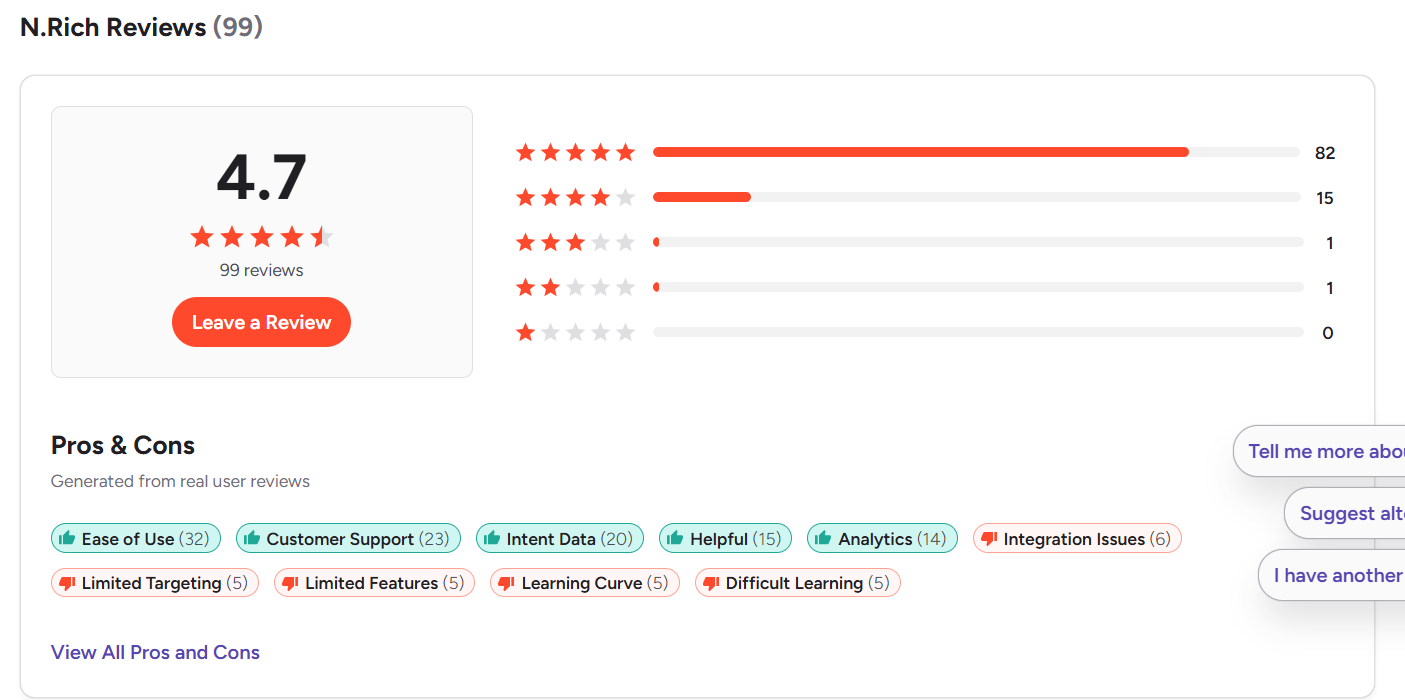
Across G2, TrustRadius, Reddit, and similar sources, a few themes show up.
Pros (According to Users)
- Support that shows up: Reviewers often describe N.Rich’s support as responsive and proactive, with regular check-ins that are not just upsells.
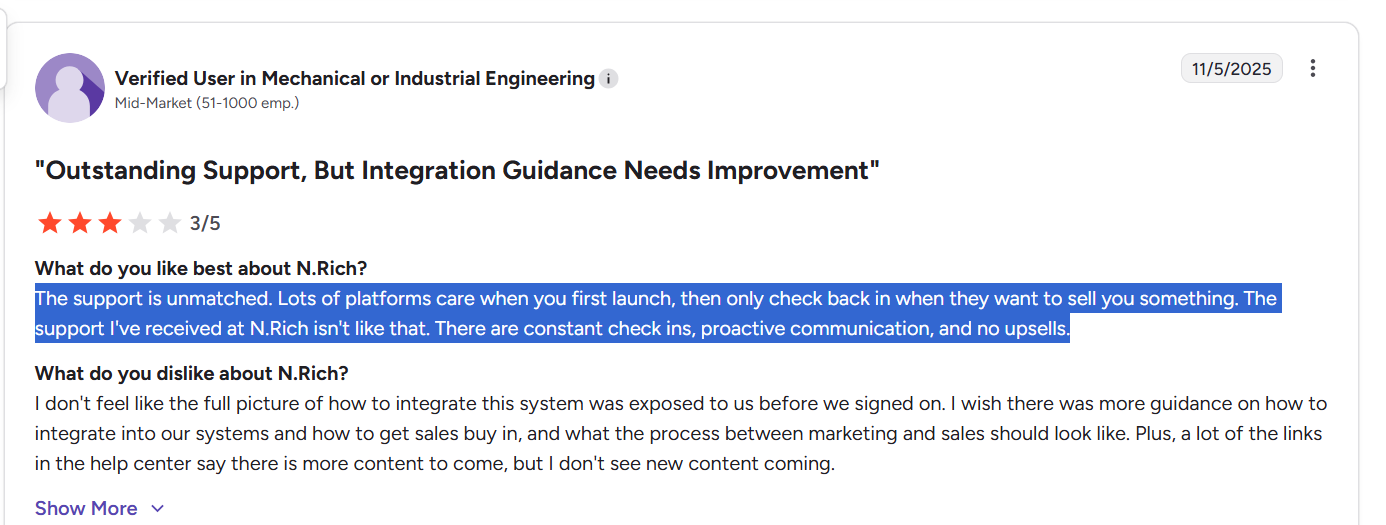
- Usable once configured: Many call it easy and even “fun” to use once lists, reports, and campaigns are in place.
- Strong intent and targeting: Users praise the quality of intent and account selection for focusing ad spend on high-value accounts.
Cons (According to Users)
- Setup takes work: Onboarding, data mapping, and reporting usually need ops involvement.
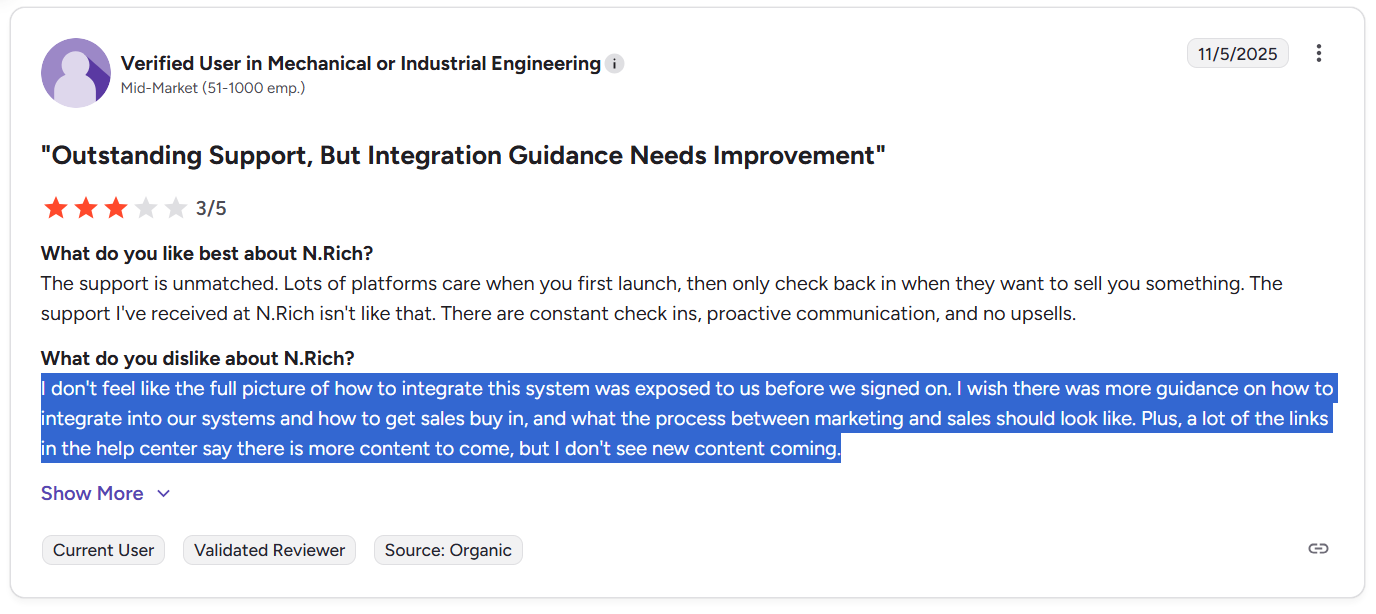
- Integrations need clearer guidance: Some reviewers report integration surprises and wish the full picture had been clearer before signing.
- Feature gaps: A few users mention limits around ad copy, session timeouts, or glitches.
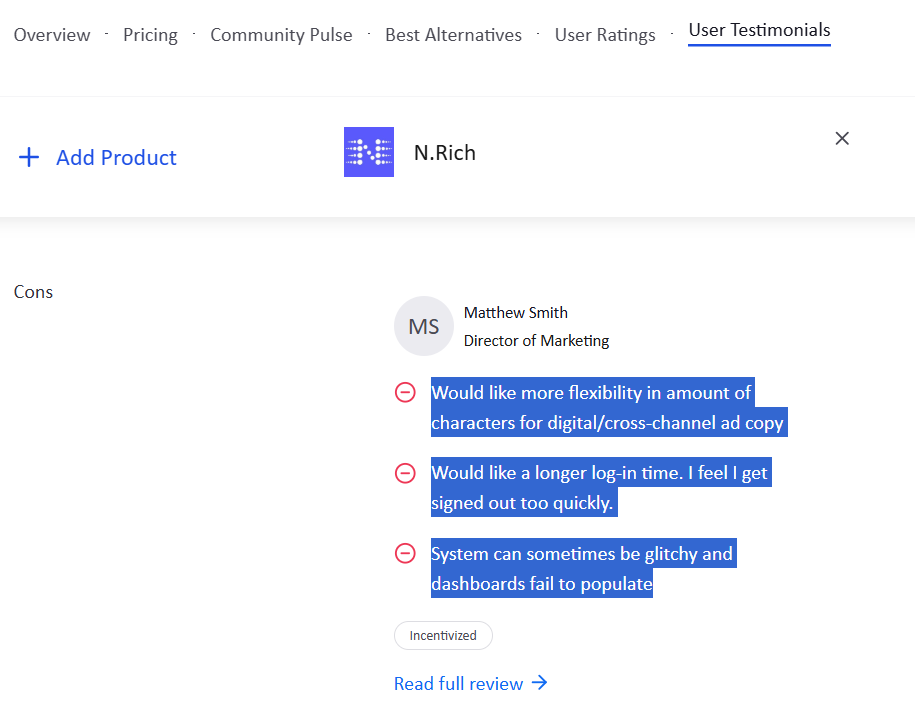
6sense Overview: Key Features, Pricing, and Reviews
6sense is an AI-driven B2B ABM platform known for revenue and sales intelligence strengths.
It enables revenue teams to answer “who is demonstrating intent” and “which accounts deserve attention right now” by combining large-scale data with machine learning.
The feature set is broad for marketing and sales teams and is designed for mid-market and enterprise organizations.
Here are the highlights:
Multi-Channel Account Advertising & Orchestration

6sense includes a B2B DSP and integrations to run ads across display, video, CTV, LinkedIn, Facebook, Google Ads, and more.
Teams can assemble dynamic audiences using firmographics, technographics, intent topics, CRM data, and similar inputs to sharpen targeting.
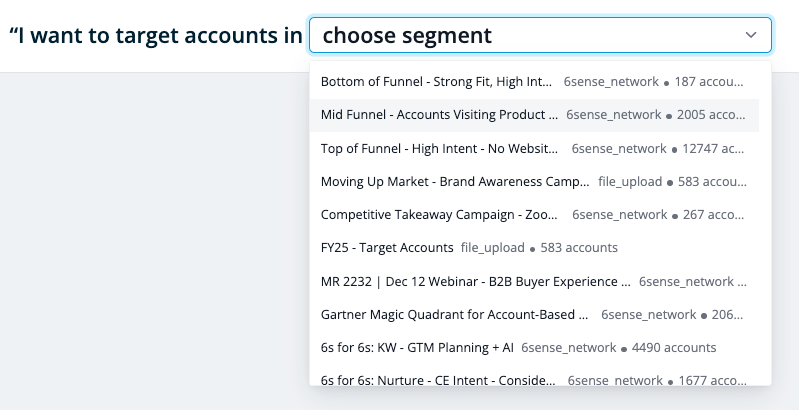
Its orchestration lets ads, email, and sales outreach coordinate based on real-time account behavior.
Predictive Intent Data & AI Scoring
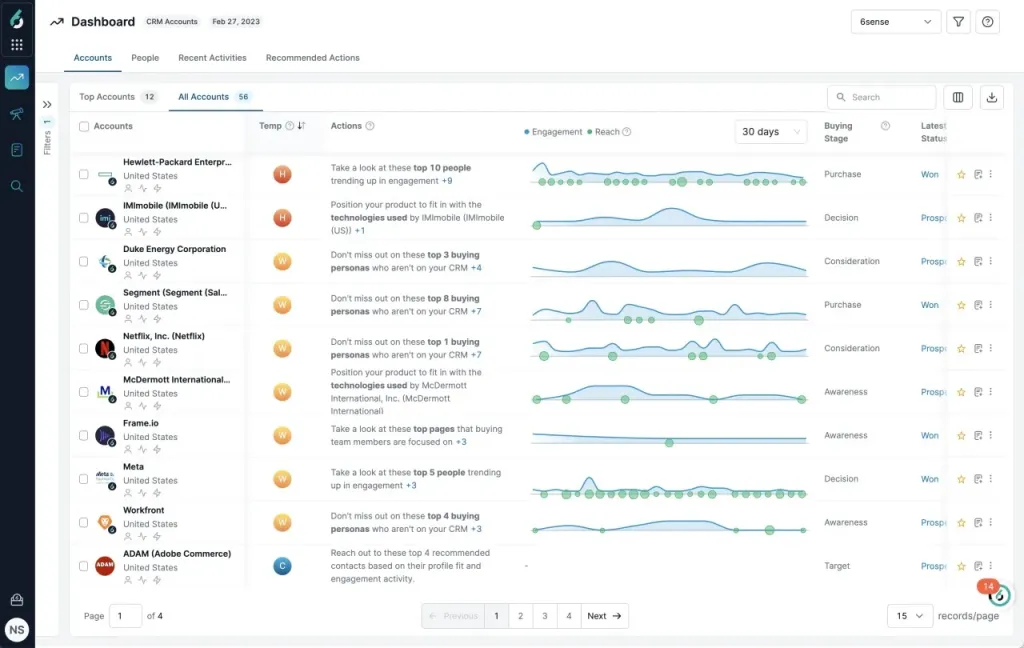
6sense’s signature capability is AI-powered intent and predictive scoring.
It blends first-party signals such as site visits, second-party review-site data, and third-party research patterns to produce a 0–100 score.
Those scores map to buying stages and likelihood to convert.
For example, 6sense’s predictive analytics can alert sales when an account surges on specific research themes or hits high-value pages, signaling possible in-market status.
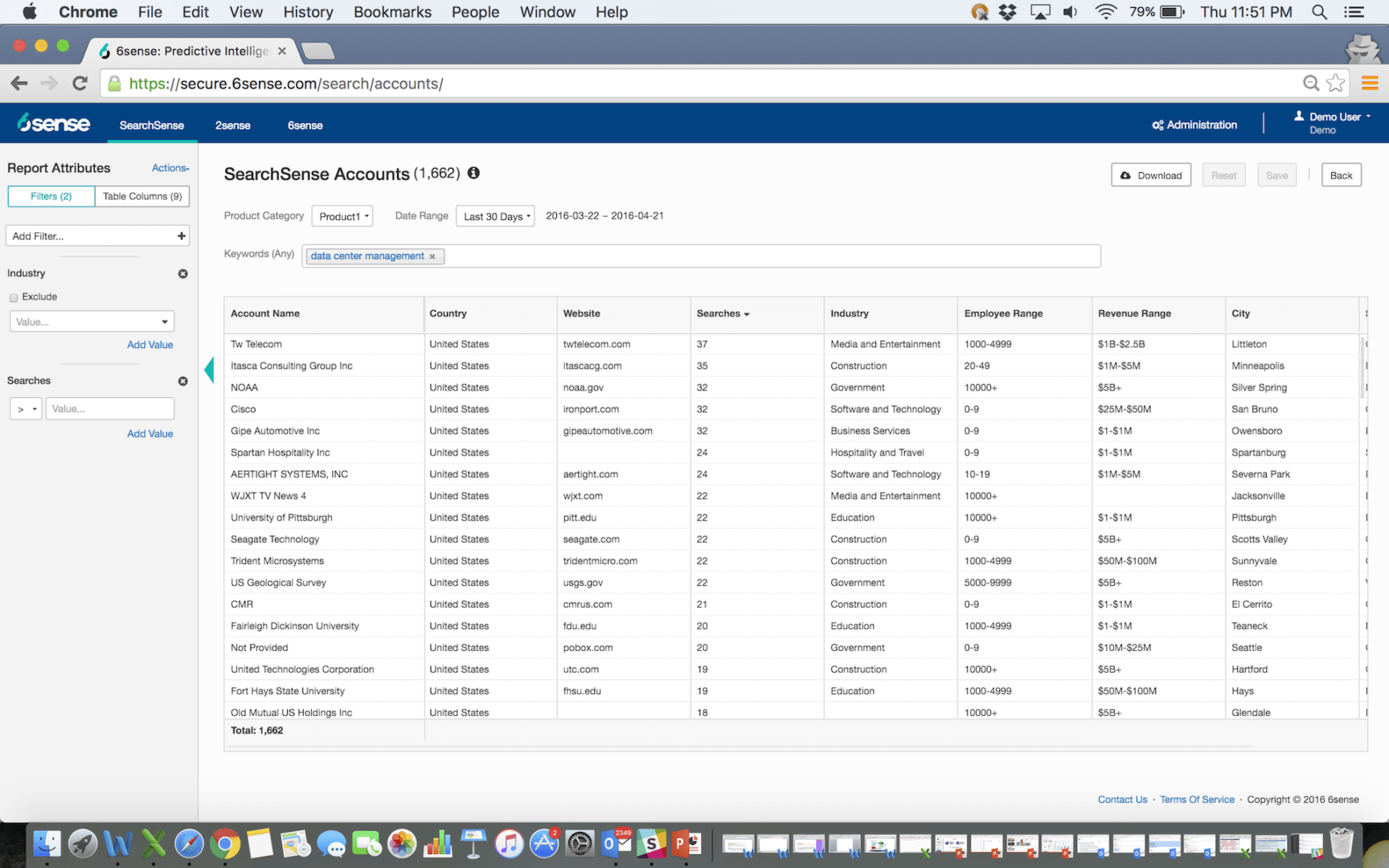
This gives sales a proactive path to prioritize high-intent accounts.
Pro Tip: Favor first-party intent over third-party keyword spikes.
ZenABM captures qualitative intent by tracking which LinkedIn ads a company actually engages with, so signals are clearer and more actionable.

Teams like Userpilot have built ABM playbooks around this idea by tagging campaigns to pain points and increasing BOFU spend on the themes accounts interact with.
Their campaign blueprint:

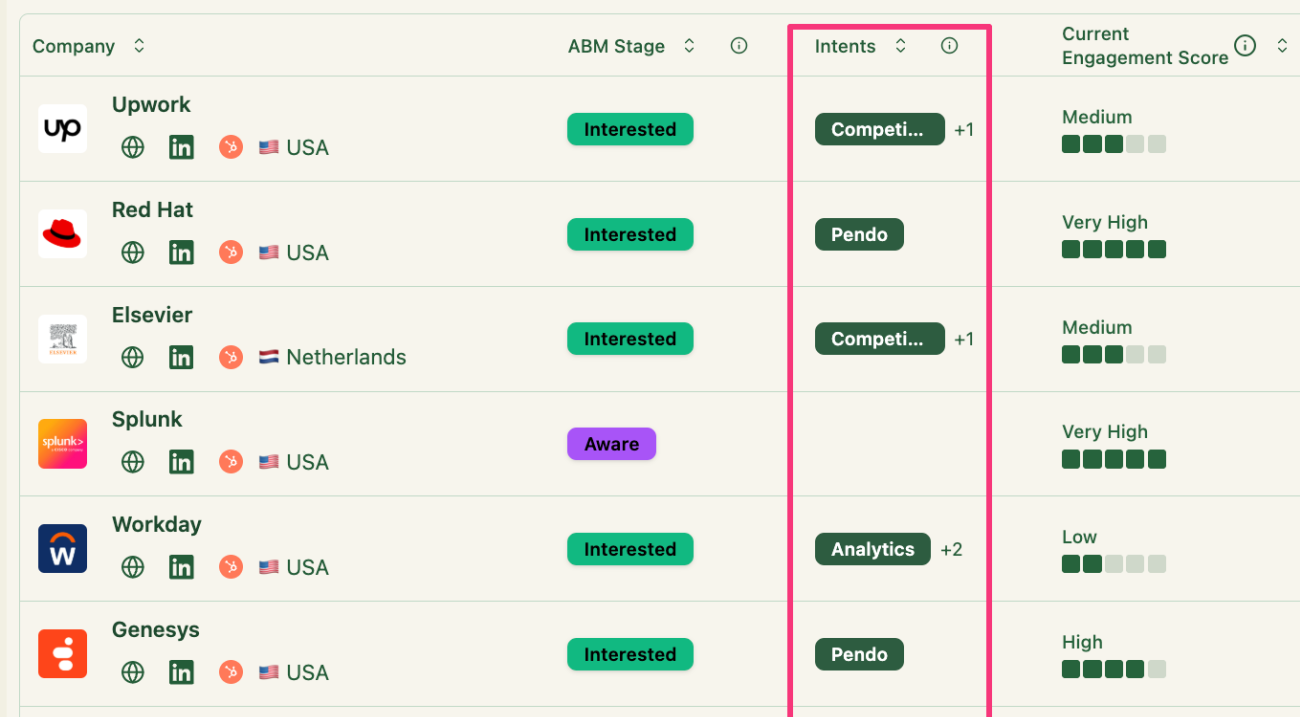
Account Intelligence & Contact Data
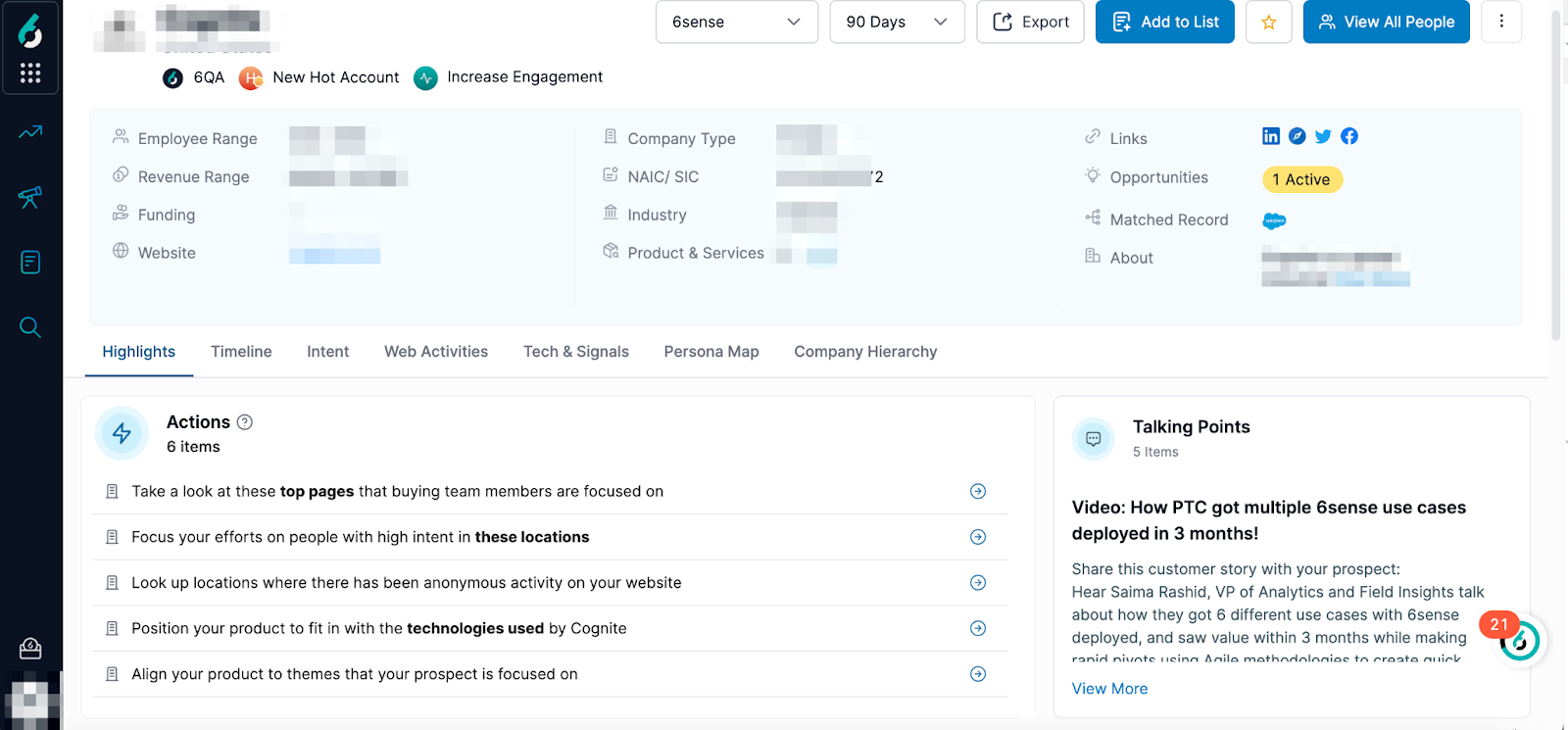
6sense compiles detailed account records with firmographics, technographics, key contacts, and behavioral context.
It often augments profiles with third-party enrichment for contact data. Some users note that international coverage can vary.
The sales intelligence features, including buying committee maps and next best actions, equip reps with useful context.
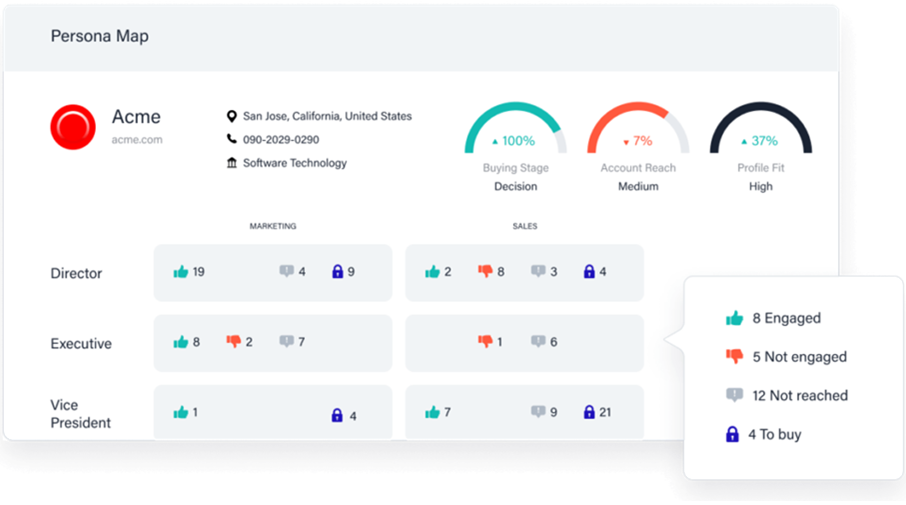
Analytics, Attribution & Reporting
![]()
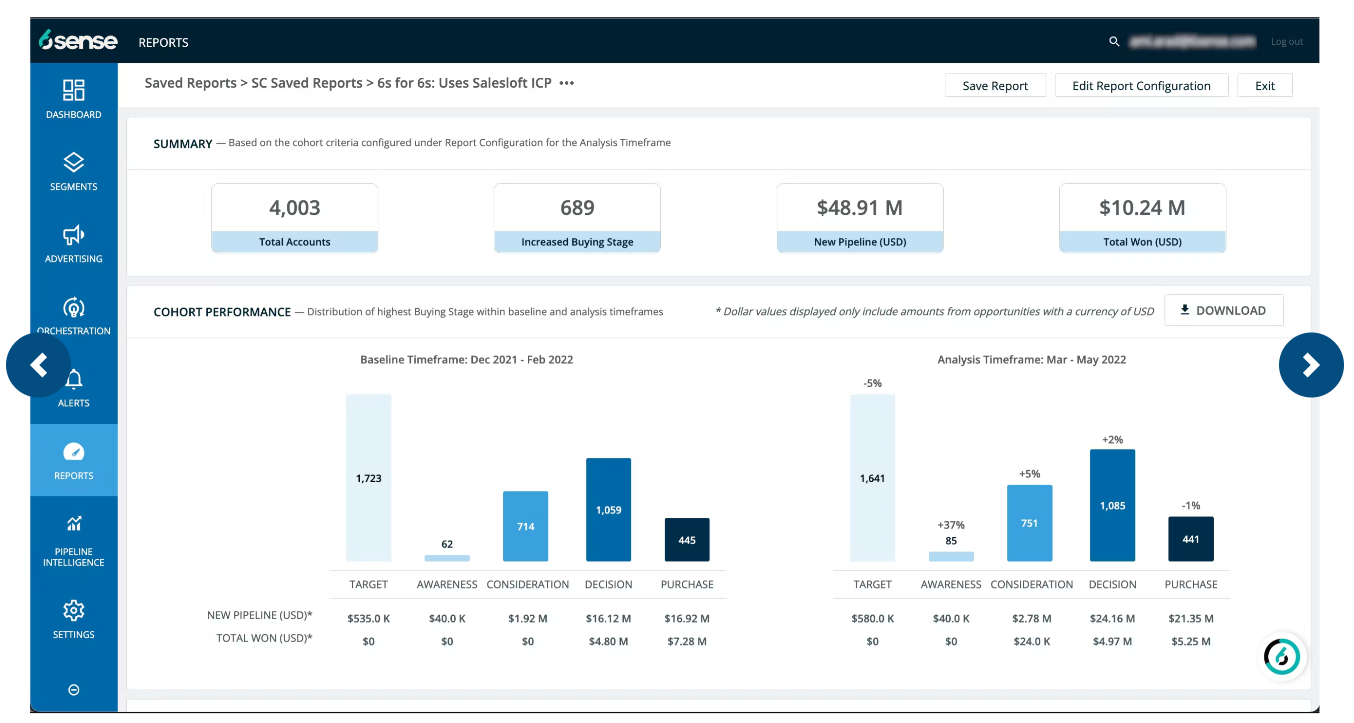
6sense offers extensive dashboards for both marketing and sales outcomes.
It supports multi-touch attribution that connects pipeline to programs, distinguishes influenced from sourced revenue, and can forecast the pipeline using AI.
You can monitor how accounts progress across buying stages and how engagement correlates with wins.
6sense also integrates with tools like Mutiny for web personalization and Drift for chat to extend experiences.
Integrations & Workflow
As an enterprise suite, 6sense connects with major CRM and marketing automation platforms such as Salesforce, HubSpot, and Marketo, plus sales engagement tools like Salesloft and Outreach, and enrichment vendors.
It aims to be the intelligence layer for your GTM stack, improving coordination between marketing and sales.
For instance, segments from 6sense can sync to LinkedIn Campaign Manager or trigger sales sequences.
This helps both teams operate from the same list of in-market accounts.
For details, see 6sense’s integrations page.
6sense Pricing
6sense is a premium platform with no public price card. You will need to engage sales for a tailored quote.
Contracts are typically annual or multi-year and may include services or media-related components depending on usage.
What should you budget?
While final numbers depend on scope, most buyers should expect mid-five figures to six figures per year for a complete rollout.
Vendr cites a median 6sense price of $54,250 per year.
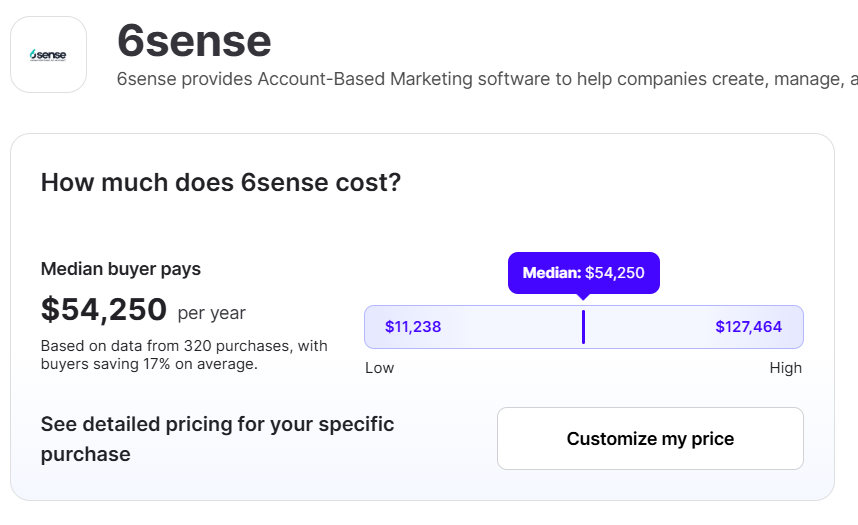
A user on Reddit shared a first-year quote of $120K from 6sense.
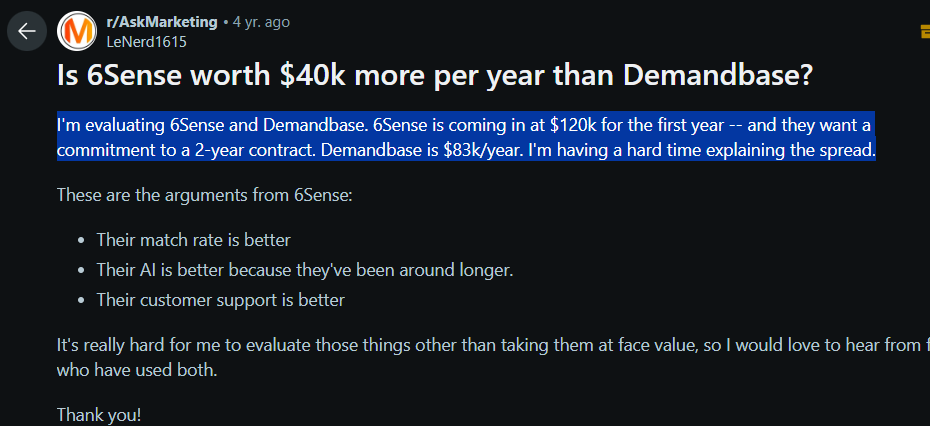
Given the investment and the ramp, 6sense fits organizations that will fully use its advanced features.
Smaller teams focused on one or two channels may find the cost and complexity tough to justify.
6sense Reviews
Users on review sites like G2, TrustRadius, and Capterra have praised 6sense for its accurate intent data, prediction insights, sales and marketing alignment, and improved lead prioritisation.
Cons expressed include a steep learning curve, performance lag, and high cost.
N.Rich vs. 6sense: Key Differences
The key differences between N.Rich vs. 6sense are tabulated here.
| Aspect | N.Rich | 6sense | Best suited for |
|---|---|---|---|
| Core positioning | ABM execution layer built on a B2B DSP with ICP, intent and programmatic workflows | AI-driven ABM and revenue intelligence suite for marketing and sales teams | Teams choosing between an execution focused tool and a full revenue platform |
| Primary channel focus | Programmatic display with LinkedIn campaign alignment | Display, video, CTV, LinkedIn, Facebook, Google Ads and more, plus coordinated outreach | Whether you need multichannel media plus orchestration or mainly DSP-based ABM |
| Intent model | Combines first-party signals with third-party intent topics and scores accounts accordingly | AI-powered predictive intent with 0 to 100 scores and buying stage classification | Teams deciding between classic topic intent vs predictive buying stage models |
| Scoring and stages | Intent scores and ICP Sales Velocity Score per account | Predictive scores mapped to funnel stages that drive prioritization and orchestration | Orgs that want simple scoring vs full stage-based playbooks |
| Campaign execution | Runs programmatic campaigns directly through its DSP and syncs with LinkedIn Ads | Activates campaigns across multiple ad networks and coordinates with email and sales touchpoints | Marketing teams focused on programmatic only vs cross-channel orchestration |
| Analytics and attribution | Account-level analytics, opportunity attribution, and velocity dashboards | Extensive revenue analytics, multi-touch attribution, stage progression and forecasting | ABM teams picking between focused campaign analytics and broad revenue reporting |
| Data and enrichment | Firmographic and technographic enrichment, CRM and MAP data for ICP and targeting | Large-scale data graph combining first-party, second-party party and third-party data for modelling | Stacks with modest vs very large data footprints and enrichment needs |
| Integrations | Salesforce, HubSpot, LinkedIn and MAP integrations plus enrichment vendors | Deep integrations with CRM, MAP, sales engagement, web personalization and chat | Teams deciding how central they want the ABM platform to be in the GTM stack |
| Pricing level | Premium pricing starting around 10,000 USD per year, Growth near 23,800 USD, Enterprise custom | Mid five-figure to six-figure contracts per year, Vendr’s median is about 54,250 USD | Budgets that can support premium vs true enterprise spend |
| Complexity and adoption | Requires onboarding and ops support, but with a narrower surface area | Steep learning curve and broad feature set that demands strong process change | Teams with lighter ops vs orgs ready for a major platform-driven transformation |
| ABM breadth | Supports ABM campaigns with intent, ICP and DSP execution | Covers end-to-end ABM and revenue workflows from detection to orchestration to reporting | Companies choosing between an ABM media engine and a full revenue platform |
N.Rich vs. 6sense: So Which Is Better for ABM?
If your ABM motion is media-heavy and centered on intent-driven programmatic display plus some LinkedIn alignment, N.Rich fits as a focused execution layer.
Its strength is turning intent data into DSP campaigns, dynamic ICP lists, and account-level analytics without trying to rebuild your entire revenue stack.
6sense is a different animal. It is closer to an operating system for revenue teams, combining predictive intent, buying stage models, orchestration across ads, email and sales, and deep revenue analytics.
It makes more sense if you have sizeable deal values, multiple channels, a big contact data footprint and a GTM team ready to adopt its workflows.
ZenABM as a LinkedIn First, First Party Lean ABM Alternative
If you mostly need first-party accuracy on LinkedIn, account scoring, ABM stages, CRM sync, and revenue attribution, a lighter option makes more sense.
This is where ZenABM comes in.
In fact, even for teams running heavy mult-channel ABM campaigns, ZenABM is valuable due to its following unique features:
Account-Level LinkedIn Engagement Tracking


ZenABM connects directly to the official LinkedIn Ads API and records account-level data for every campaign.
You see which companies view and engage with your ads using first-party LinkedIn data instead of noisy IP or cookie matching. A Syft study suggests IP identification accuracy peaks around 42 percent, which is why ZenABM treats ad engagement as the primary intent signal.
Real Time Engagement Scoring & ABM Stages

ZenABM updates engagement scores continuously as accounts interact with your ads. The interface shows a full touchpoint history and lets you define custom stages such as Identified, Aware, Engaged, Interested, and Opportunity.


CRM Integration and Workflows
ZenABM syncs bi-directionally with HubSpot and adds Salesforce support on higher plans. All LinkedIn metrics can be written as company properties in your CRM.
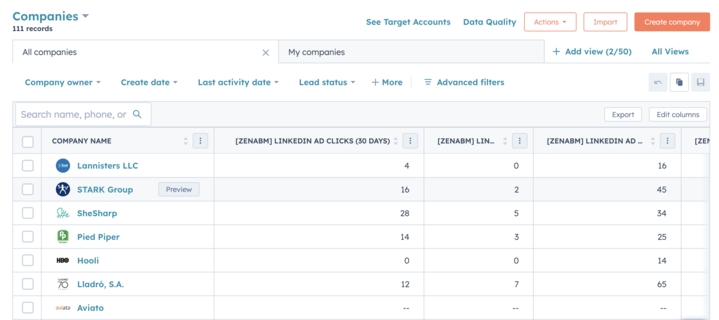
When an account crosses your score threshold, ZenABM updates the stage and can assign a BDR automatically.

Intent Tagging and ABM Analytics
ZenABM lets you pull intent topics from LinkedIn campaigns and tag each campaign by feature, use case, or offer.
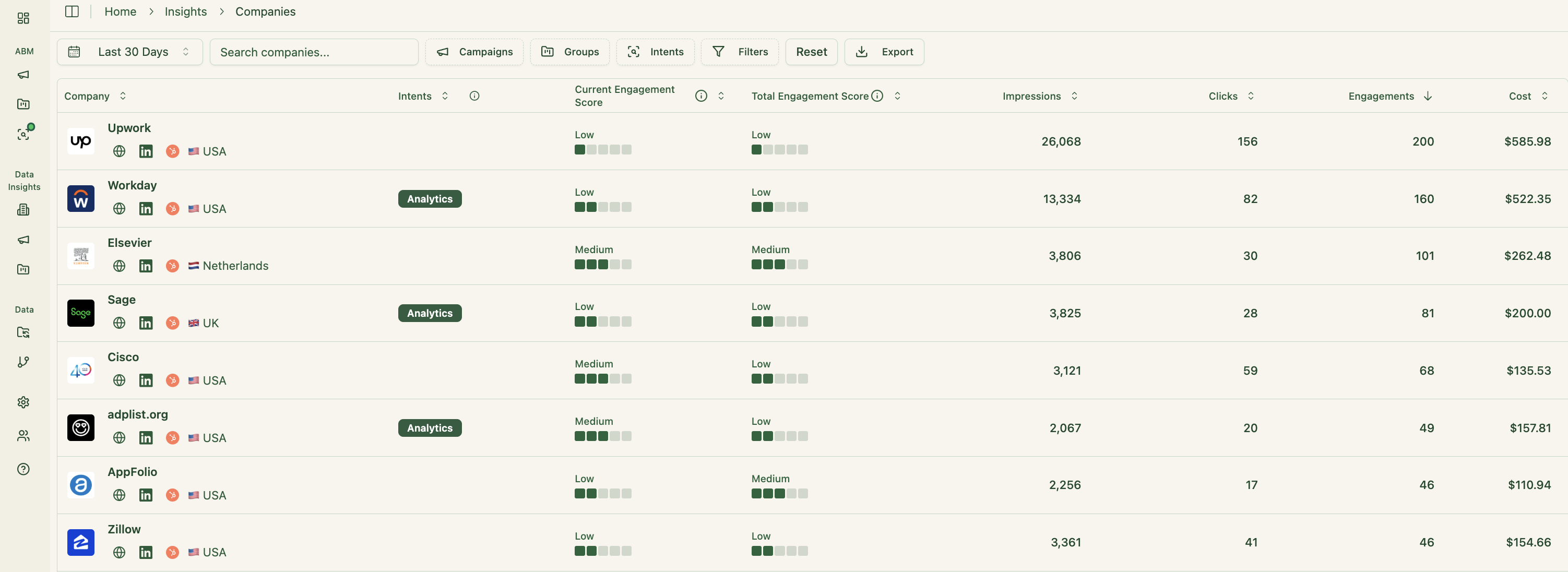
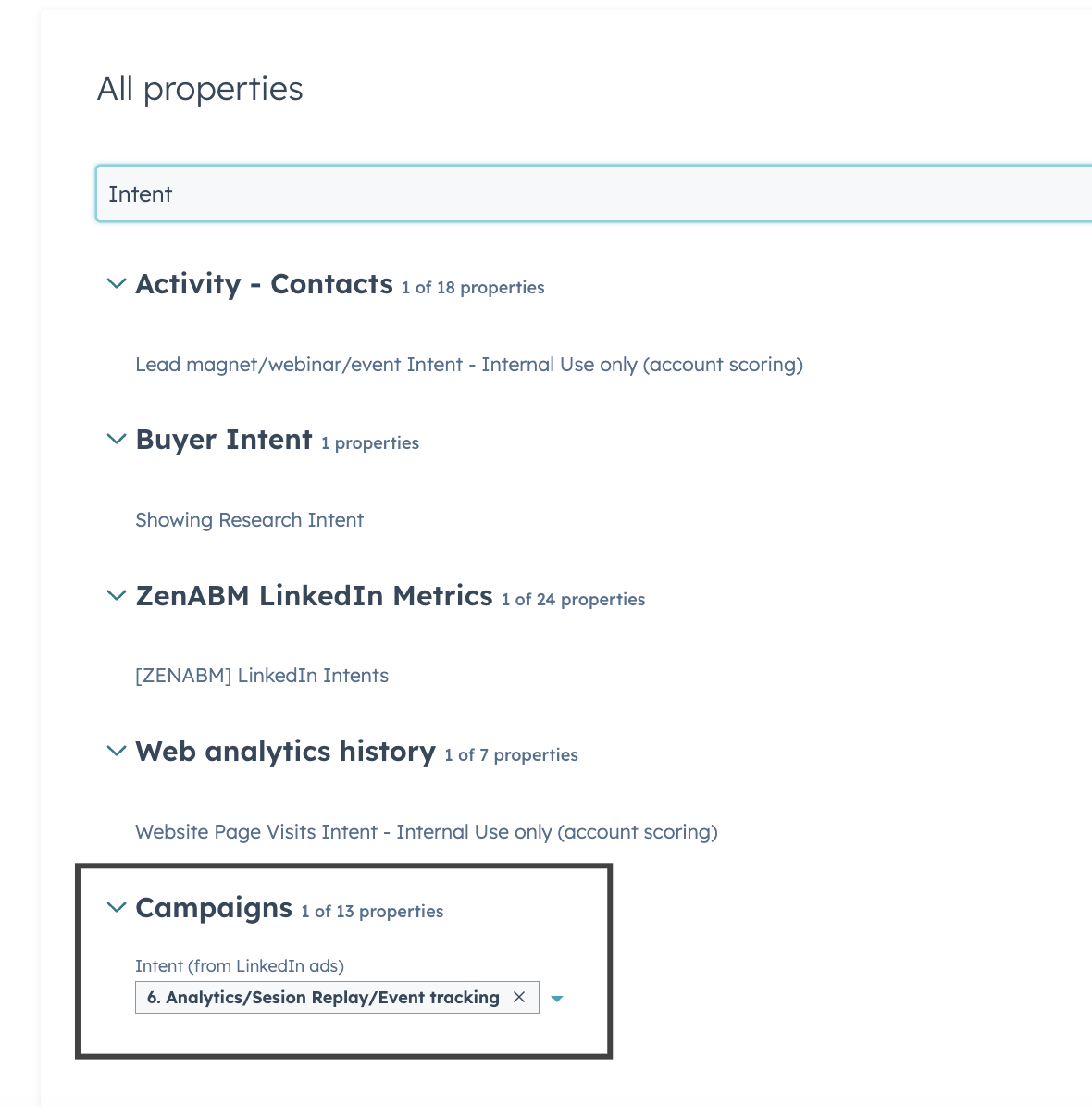
ZenABM includes ABM dashboards that tie LinkedIn ads to account engagement, stages, and revenue. You can see performance from ABM initiatives down to campaign groups and individual ads, and because ZenABM stores deal value and ad spend per company and campaign, it calculates ROAS and pipeline per dollar.
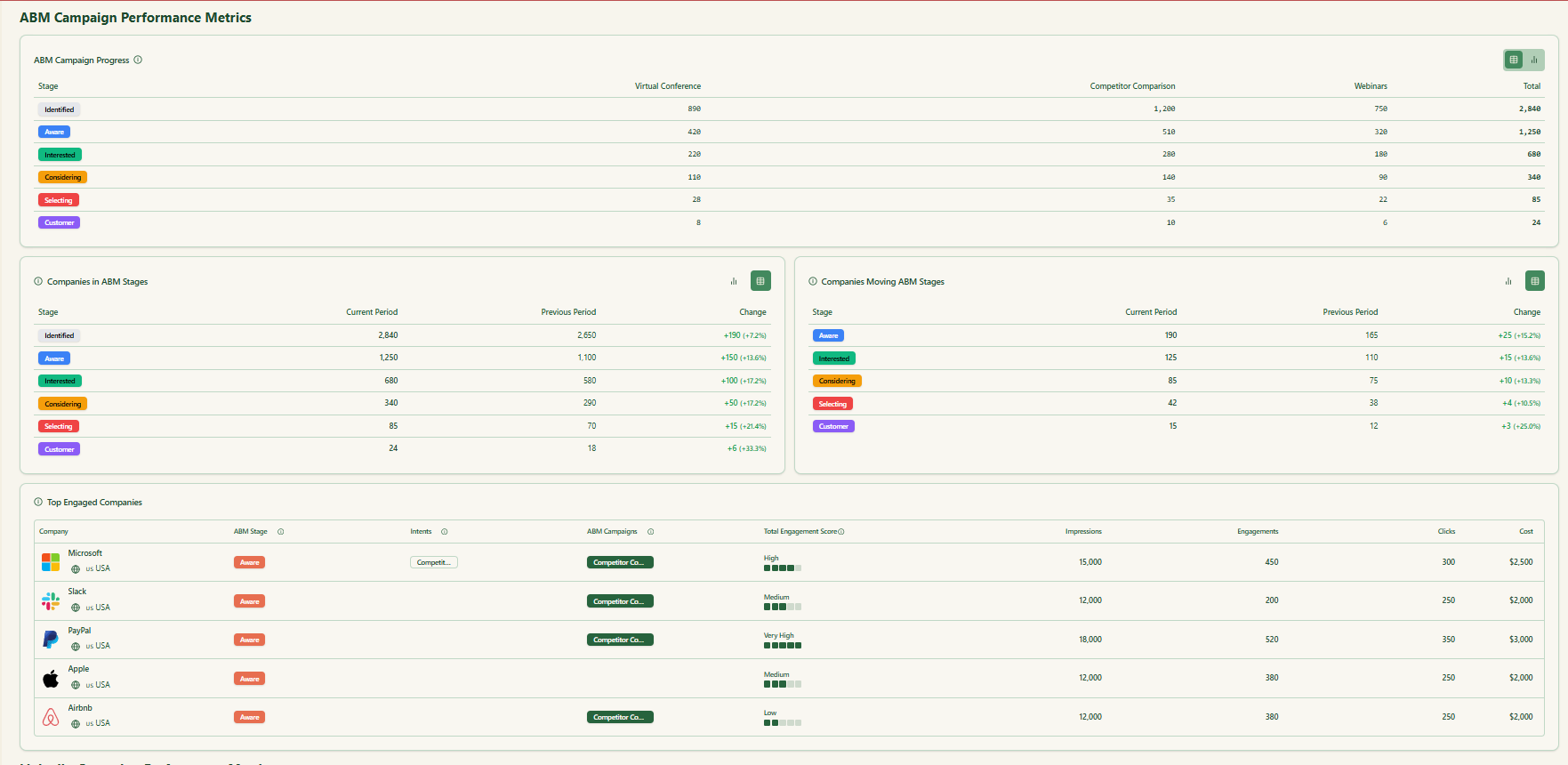

Webhooks, Job Title Analytics & Campaign Objects
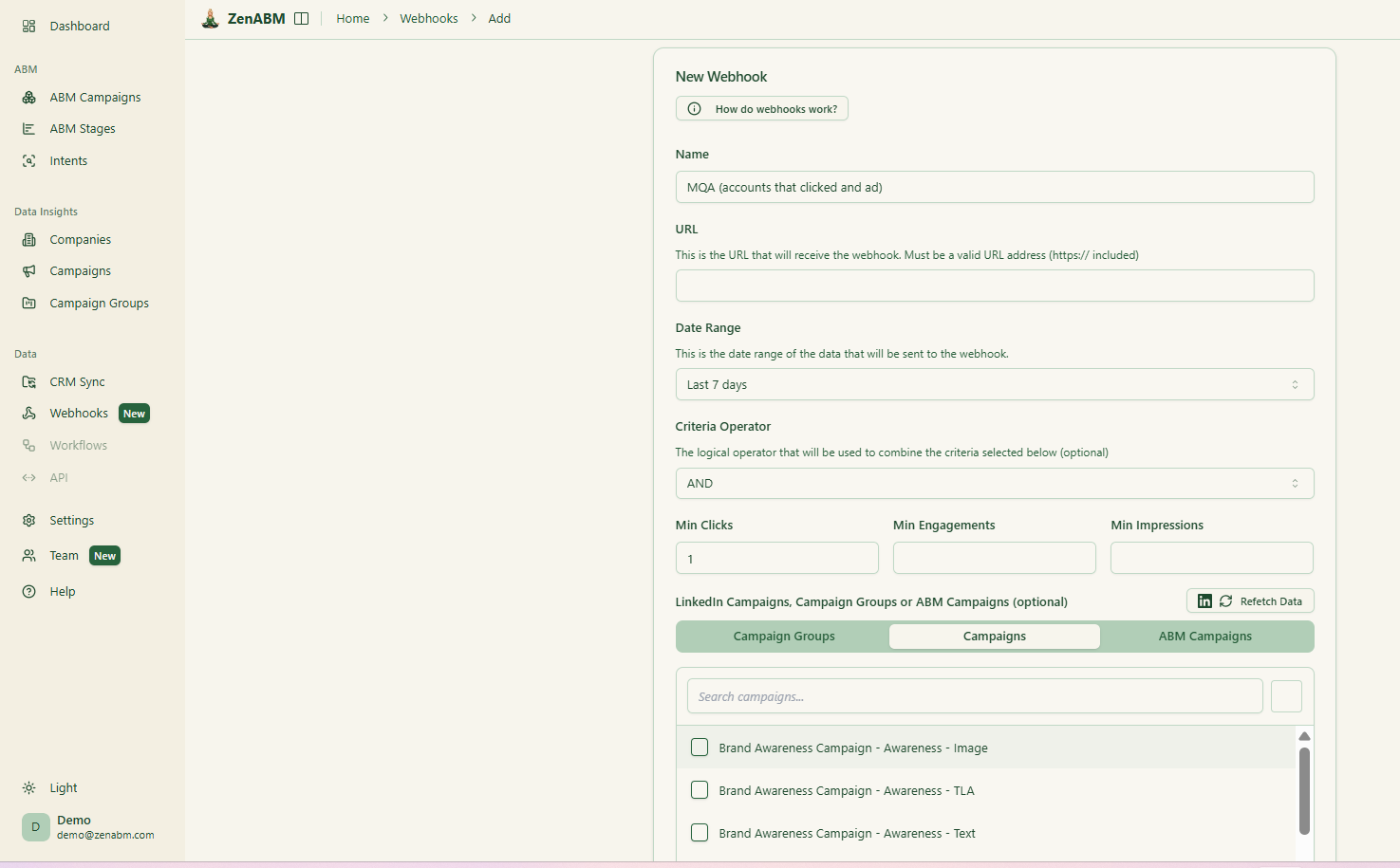
ZenABM webhooks send events into your stack for Slack alerts, enrichment flows, and other automation.
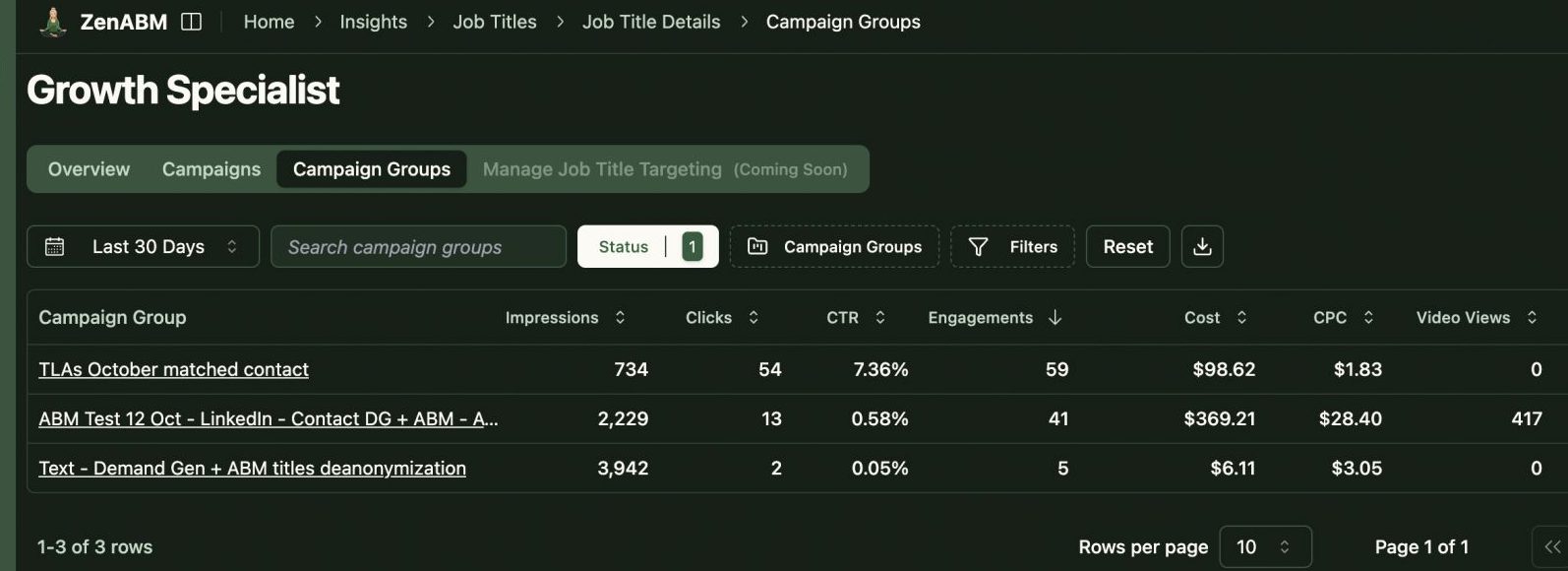
You can also group LinkedIn campaigns into ABM campaign objects to view performance across markets, personas, or creative clusters instead of juggling isolated reports.
AI Chatbot & Multi Client Workspace
ZenABM includes an AI chatbot on top of your LinkedIn API data and ABM model so you can ask questions like “Which accounts moved from Interested to Selecting last month?” or “What is my pipeline per dollar on retargeting campaigns?”.
It also supports agencies via a multi-client workspace, so you can manage several ad accounts and clients with separate ABM campaigns, dashboards, and reporting without constant account switching in Campaign Manager.
ZenABM Pricing
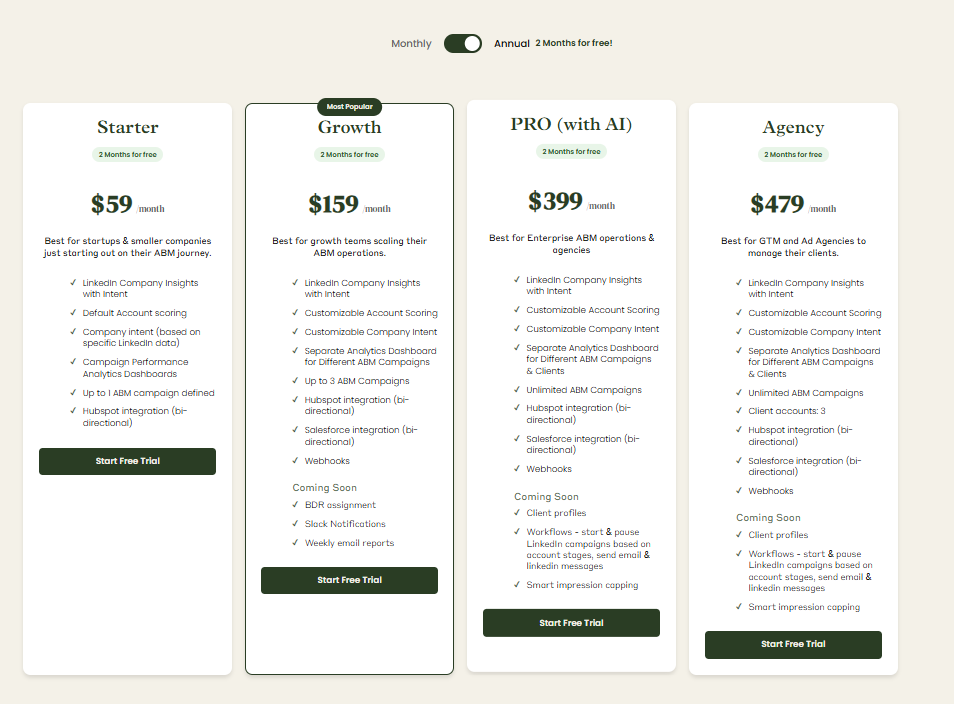
Plans start at $59/month for Starter, $159/month for Growth, $399/month for Pro (AI), and $479/month for Agency.
Even the agency plan stays under $6,000 per year, with all tiers including core LinkedIn ABM capabilities.
Higher tiers mainly raise limits and add Salesforce sync.
All plans include a 37-day trial period.
Conclusion
N.Rich and 6sense both sit in the premium ABM bracket, but they solve slightly different problems. N.Rich is strongest when you want to turn intent and ICP models into concrete programmatic campaigns, then track performance at the account level without rebuilding your entire revenue stack around a new source of truth.
6sense makes more sense when you want a central intelligence layer that tells you which accounts are in market, which stage they sit in, and how to orchestrate ads, email and sales in response. It rewards companies with complex, multichannel motions and larger budgets that can actually exploit predictive models and broad integrations.
If your most important channel is LinkedIn and you really care about clear first-party signals, account scoring, ABM stages, CRM sync, and company-level revenue attribution, ZenABM usually lands closer to what you need day to day, without dragging you into six-figure contracts or year-long rollouts.

